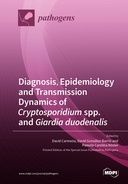Explore

Diagnosis, Epidemiology and Transmission Dynamics of Cryptosporidium spp. and Giardia duodenalis
0 Ungluers have
Faved this Work
Login to Fave
The enteric protozoans Cryptosporidium spp. and Giardia duodenalis are the most common diarrhoea-causing protozoan parasites worldwide. Cryptosporidium spp. is a leading cause of diarrhoea morbidity and mortality in children younger than 5 years of age in poor-resource settings in sub-Saharan Africa and South Asia. Although infection by G. duodenalis is rarely a fatal condition, giardiasis is commonly associated with childhood growth faltering and cognitive impairment. Because of their significant socioeconomic impact, particularly in low-income countries, giardiasis and cryptosporidiosis joined the “Neglected Disease Initiative” launched by the World Health Organization in 2004. Both Cryptosporidium spp. and G. duodenalis are ubiquitous in the environment and can infect a wide range of hosts with different specificities, meaning that humans may acquire the infection via waterborne, foodborne, or zoonotic transmission. Recent advances in detection and molecular epidemiology have indicated that certain species/genotypes of Cryptosporidium and G. duodenalis have an expanded range of suitable hosts, suggesting that their transmission pathways are more intricate than previously thought, challenging our current notion of host specificities. Therefore, there is a clear need for more studies that aim to investigate the frequency and molecular diversity of these parasites in humans, production and companion animals, and wildlife species. This information would be extremely useful to elucidate the transmission dynamics of cryptosporidiosis and giardiasis and to investigate the exact contribution of zoonotic events to human infections.
This book is included in DOAB.
Why read this book? Have your say.
You must be logged in to comment.
Rights Information
Are you the author or publisher of this work? If so, you can claim it as yours by registering as an Unglue.it rights holder.Downloads
This work has been downloaded 134 times via unglue.it ebook links.
- 134 - pdf (CC BY) at Unglue.it.
Keywords
- 60-kDa glycoprotein
- acute diarrhea
- Amazon
- asymptomatic
- Bactrian camels
- bamboo rat
- Biology, Life Sciences
- Blastocystis
- Blastocystis sp.
- Brazil
- Children
- China
- coinfection
- Community
- coypus (Myocastor coypus)
- Cryptosporidium
- Cryptosporidium cuniculus
- Cryptosporidium felis
- Cryptosporidium parvum
- Cryptosporidium spp.
- Cryptosporidium xiaoi
- Detection
- Diagnosis
- diarrhoea
- Egypt
- Entamoeba histolytica
- enteric parasites
- enteric protists
- Enterocytozoon bieneusi
- Epidemiology
- Europe
- Gems
- genetic diversity
- Genetic Variation
- genotype
- genotyping
- Giardia
- Giardia duodenalis
- gp60
- gp60 gene
- host adaptation
- host specificity
- human pathogen
- indigenous
- Mathematics & science
- molecular diversity
- molecular epidemiology
- Mozambique
- multi-locus genotype
- n/a
- parasite
- Parasitology
- PCR
- PCR (polymerase chain reaction)
- PCR-RFLP
- pet dogs and cats
- Prevalence
- protist
- Public Health
- Rabbits
- Reference, information & interdisciplinary subjects
- Research & information: general
- risk association
- risk factor
- scandinavia
- sensitivity
- Specificity
- sporozoa
- ssu rRNA
- subtype
- subtypes
- subtyping
- Tapirapé
- Transmission
- Yunnan province
- zoonoses
- zoonosis
- zoonotic genotypes
- zoonotic potential
- zoonotic transmission
Links
DOI: 10.3390/books978-3-0365-3079-6Editions

